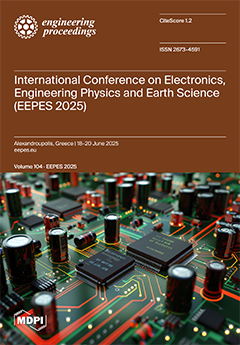Eng. Proc., 2025, EEPES 2025
The International Conference on Electronics, Engineering Physics and Earth Science (EEPES 2025)
Alexandroupolis, Greece | 18–20 June 2025
Volume Editors:
Teodor Iliev, University of Ruse, Ruse, Bulgaria
Ivaylo Stoyanov, University of Ruse, Ruse, Bulgaria
Grigor Mihaylov, University of Telecommunications and Post, Sofia, Bulgaria
Panagiotis Kogias, Democritus University of Thrace, Kavala, Greece
Jacob Fantidis, Democritus University of Thrace, Kavala, Greece
Printed Edition Available!
- Issues are regarded as officially published after their release is announced to the table of contents alert mailing list.
- You may sign up for e-mail alerts to receive table of contents of newly released issues.
- PDF is the official format for papers published in both, html and pdf forms. To view the papers in pdf format, click on the "PDF Full-text" link, and use the free Adobe Reader to open them.




